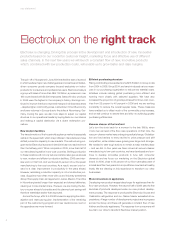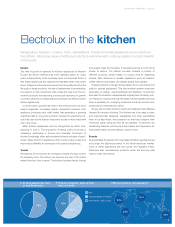Electrolux 2006 Annual Report Download - page 9
Download and view the complete annual report
Please find page 9 of the 2006 Electrolux annual report below. You can navigate through the pages in the report by either clicking on the pages listed below, or by using the keyword search tool below to find specific information within the annual report.
consumer durables / kitchen
Electrolux in the kitchen
Market
The rate of growth in demand for kitchen appliances in Western
Europe and North America has been relatively stable for many
years, independently of the business cycle. An important factor is
that these appliances are replaced immediately when they break
down. Despite continuous improvements in the quality and thus the
life cycle of these products, the rate of replacement is accelerating.
One reason is that consumers often prefer the new and more in-
novative products that are being continuously launched. In growth
countries, demand is increasing as more people can afford modern
kitchen appliances.
In recent years, growth has been in the premium and low-price
market segments. Increased global competition between both
appliance producers and retail chains has generated a growing
customer base for low-price products. Demand for premium prod-
ucts has risen as the kitchen has come to play a more important
role in the home.
Most kitchen appliances can be categorized as either free-
standing or built-in. The popularity of having built-in products is
increasing, particularly in Europe and Australia. Producers of
kitchen furnishings often sell complete kitchens inclusive of appli-
ances. Sales of built-in appliances often involve higher prices and
improved profi t ability for producers of household appliances.
Trends
Perceptions of the kitchen are changing. Instead of being a place
for preparing food, the kitchen has become the part of the home
where the most time is spent. The kitchen is where family, friends
and guests meet and socialize. It has also become a room that is
shown to visitors. The kitchen normally contains a number of
different products, which makes it a unique area for displaying
brands. With reference to smaller appliances such as toasters,
coffee-makers and mixers, the display area is even greater.
Preparing food is no longer simply a daily chore, but a hobby that
calls for special equipment. This has involved greater consumer
emphasis on design, user-friendliness and fl exibility. Consumers
also want to be able to use appliances logically and intuitively, with-
out having to consult a manual. Not least, kitchen appliances must
have a capability for preparing traditional foods as well as more
advanced and international cuisine.
Strong world-wide trends for health and wellness have affected
demand for modern kitchens. The kitchen has to be easy to clean
and ergonomically designed. Vegetables and other perishables
have to be kept fresh, and prepared so that they preserve their
nutritional value, using as little fat as possible. Consumers are
demanding features such as ice-cube makers and dispensers for
carbonated water, and are willing to pay for them.
Brands
Approximately 50 percent of Group sales of kitchen appliances are
sold under the Electrolux brand. In the North American market,
most of these appliances are sold under the Frigidaire brand.
Electrolux also manufactures products which are sold by retail
chains under own brands.
Refrigerators, freezers, cookers, hobs, dishwashers, hoods and small appliances are products for
the kitchen. Electrolux range of kitchen products is extensive with a strong position in most markets
in the world.
56%
32%
23%
23%
19%
» Market shares of core appliances
» Product categories, share of total
sales in kitchen
40%
12%
48%
Dish
Cold (refrigerators, freezers)
Hot (cookers, hobs, ovens)
» Kitchen appliances, share
of total Group sales
5






















